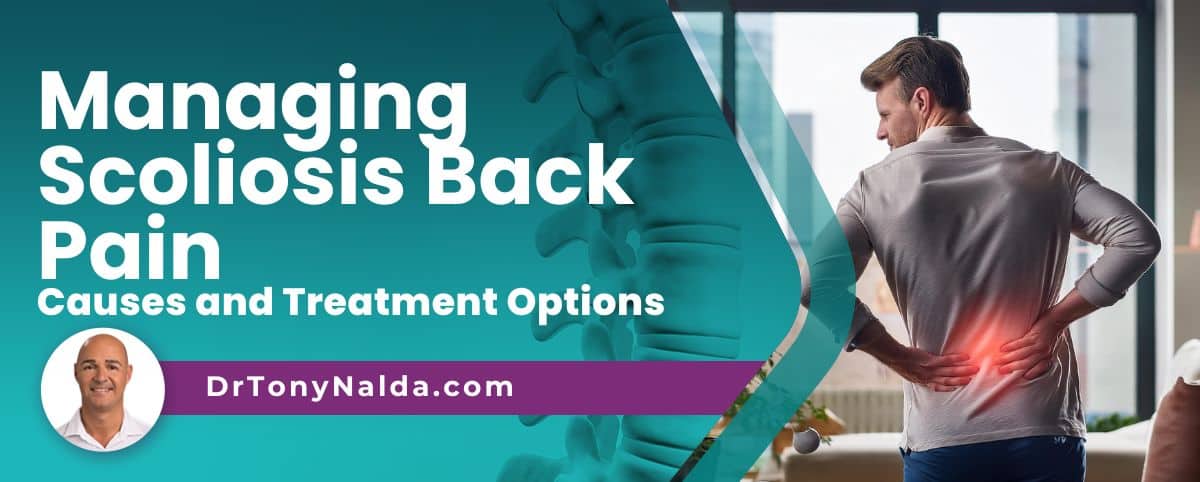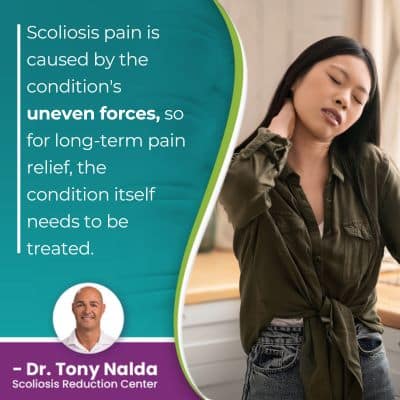Managing Scoliosis Back Pain: Causes and Treatment Options

The best way to manage symptoms of scoliosis is to treat their underlying cause: the condition itself. Common scoliosis symptoms can include postural changes, like uneven shoulders and hips, and pain once conditions become compressive; continue reading to learn why that is.
Scoliosis isn't always a painful condition, but it can be. There are a number of factors that shape how painful a condition is likely to be including patient age, condition type, and severity. The best way to manage scoliosis back pain is to treat it proactively.
Scoliosis back pain relief is important for quality of life, so let's talk about why back pain will affect some patients, but not others.
Table of Contents
What Causes Scoliosis Back Pain?
Scoliosis causes an unnatural sideways-bending and rotating spinal curve to develop, and this introduces a lot of uneven forces to the spine, its surrounding muscles and nerves, and the entire body.
Scoliosis back pain can have different sources, but all are related to the asymmetrical effects of the condition.
Scoliosis back pain is the worst when scoliosis is severe; no two cases are the same, and scoliosis can range widely in severity.
Scoliosis ranges from mild scoliosis to moderate scoliosis, severe and very severe scoliosis, and the more severe a condition is, the more noticeable its effects are going to be.
The larger a scoliotic curve is, the more severe it is, and as a progressive condition, the nature of scoliosis is to get worse over time; progression can cause increasing levels of back pain.
Progression and Pain
As a progressive condition, virtually all cases of scoliosis are guaranteed to get worse at some point, and while we don't always know what causes most cases of scoliosis to develop initially, we know it's growth that causes them to progress.
Scoliosis progressing means the size and rotation of the unnatural spinal curve is getting larger and worse, and this means the condition's effects are also becoming more severe and noticeable.
Scoliosis progression is caused by growth, which is why childhood scoliosis should always be taken seriously.
So where a scoliosis is at the time of diagnosis doesn't mean that's where it will stay, especially without treatment that counteracts the condition's progressive nature.
As scoliosis becomes more severe, its effects become more severe, and can involve pain.
Scoliosis Muscular Imbalance
 A common effect of scoliosis is a muscular imbalance, and this is caused by the spine's unnatural curve pulling its surrounding muscles in different directions.
A common effect of scoliosis is a muscular imbalance, and this is caused by the spine's unnatural curve pulling its surrounding muscles in different directions.
Muscles on one side of the spine can become weak from underuse while muscles on the other side can become sore and stretched from overuse, and this type of imbalance can be painful, involve muscle spasms, and can get worse if the unhealthy spinal curve gets larger.
If the spine's surrounding muscles are unbalanced, this can cause pain from stiff, sore, and strained muscles.
Compression and Pain
Scoliosis isn't always painful; in fact, the condition isn't commonly painful for children, but pain is the main symptom of scoliosis in adults.
Compression is uneven pressure, and scoliosis doesn't become a compressive condition until skeletal maturity has been reached; in young patients whose spines are still growing, the constant lengthening motion of growth counteracts the compressive force of the unnatural spinal curve.
When growth has stopped, it's compression of the spine and its surrounding muscles and nerves that causes the majority of condition-related pain.
Scoliosis back pain can involve muscle pain, localized back pain, and pain that radiates into the extremities due to nerve compression, and nerve-related back pain can range from mild and intermittent to chronic and debilitating.
How to Treat Scoliosis Back Pain
Pain and condition effects are symptoms of scoliosis; scoliosis treatment has to address their underlying cause, the condition itself.
Scoliosis pain is caused by the condition's uneven forces, so for long-term pain relief, the condition itself needs to be treated.
Chronic back pain can impact quality of life, and for any type of long-term sustainable pain relief, the condition has to be impacted on multiple levels.
People with scoliosis have an important decision to make: how to treat the condition moving forward.
There are two main scoliosis treatment approaches for patients to consider, and both affect the spine differently, so it's important that educated treatment decisions are being made.
As a progressive condition, scoliosis can become significantly worse over time, particularly if left untreated or not treated proactively.
Conservative Scoliosis Treatment
Here at the Scoliosis Reduction Center®, patients benefit from a nonsurgical scoliosis treatment approach that integrates multiple different treatment disciplines so treatment plans can be fully customized and conditions can be impacted on every level.
So let's talk about how conservative treatment can help with the different causes of scoliosis back pain.
Scoliosis treatment works towards counteracting the condition's progressive nature, so trying to reduce the size of the unnatural spinal curve so conditions become less severe, instead of more severe over time, is a focus of treatment.
Chiropractic Care, Physical Therapy, and Scoliosis Bracing
To impact scoliosis on a structural level and address the abnormality within the spine itself, condition-specific chiropractic care can involve a series of techniques and manual adjustments that work towards repositioning the curve's most-tilted vertebrae back into alignment with the rest of the spine.
To prevent scoliosis from getting worse, the spine itself can be corrected by restoring as much of its healthy curves as possible and improving its general biomechanics; this relieves back pain as the spine's adverse tension is reduced alongside the curvature size.
Physical therapy and scoliosis-specific exercises can help prepare the spine and its surroundings for treatment; they can help by strengthening the spine's surrounding muscles so they can better support and stabilize the spine.
Physical therapy can also help address any related muscular imbalance by strengthening weak muscles and relaxing strained muscles; this can help alleviate painful muscle strain and muscle spasms.
Corrective bracing can help augment corrective treatment results by pushing the spine into a corrective position, and as bracing is particularly effective on growing spines, it's a regular facet of childhood scoliosis treatment.
In the treatment of adult scoliosis, bracing is used more for short-term pain relief and stability than working towards corrective results.
Working towards a curvature reduction and increasing core strength is the nonsurgical strategy for addressing scoliosis and can relieve pain by treating its underlying cause: the condition itself.
Scoliosis Surgery and Back Pain
 For those who choose a surgical treatment response, this involves spinal fusion surgery.
For those who choose a surgical treatment response, this involves spinal fusion surgery.
Spinal fusion involves fusing the curve's most-tilted vertebrae into one solid bone, removing the intervertebral discs that sit between adjacent vertebrae to be fused, and attaching metal rods to the spine to hold it in place.
When it comes to back pain, while spinal fusion can straighten a bent spine, the way it does so can cost the spine in terms of its strength, function, and flexibility.
Many patients also find an increase in back pain at the fusion site, and the more vertebrae that are fused, the more likely the site is to be painful; fusing the spine is contrary to its movement-based design and the spinal rigidity and surrounding muscle stiffness can be another cause of scoliosis back pain.
Scoliosis surgery carries some potentially serious complications, both associated with the procedure itself and long-term effects: wound infection, pain, nerve damage, excessive blood loss, and a noticeable loss in spinal flexibility and range of motion.
Over the counter painkillers can help with short-term pain management, but when it comes to quality of life, a permanent long-term sustainable solution is needed, and this can be found in a proactive noninvasive treatment approach.
Conclusion
Scoliosis is a highly-variable spinal condition that ranges in severity from mild scoliosis to moderate scoliosis, severe and very severe scoliosis.
The more severe a scoliosis is, the more likely it is to be painful, and once scoliosis becomes compressive when growth has stopped, significant pain can be an issue.
Pinched nerves, leg pain, chest pain, and muscle pain can become issues, particularly in adults for whom scoliosis is compressive.
Back pain can be felt in the affected spinal section, the spine's surrounding muscles and nerves, and throughout the body due to the condition's uneven forces.
In children, the earliest signs of scoliosis are often uneven shoulders, uneven shoulders blades, development of a rib cage arch, arms and legs that appear to hang at different lengths; abnormal posture is the main effect of childhood scoliosis.
In adults, postural changes are common along with a prominent lean to one side, but it's scoliosis pain that brings the majority of adults in to see me for a diagnosis and treatment, and degenerative scoliosis affects older adults and can be particularly painful as natural age-related spinal degeneration is a factor.
When it comes to treating scoliosis, scoliosis cases that are diagnosed and treated while still mild are the most likely to respond well; the spine is still flexible and responsive and the condition's effects aren't yet well established.
Scoliosis back pain can be a non-issue for some patients, but for others, particularly adults, it can range from mild and intermittent to chronic and debilitating, and regardless of condition type or severity, the best remedy is proactive treatment that addresses the condition's underlying structural nature.
Dr. Tony Nalda
DOCTOR OF CHIROPRACTIC
After receiving an undergraduate degree in psychology and his Doctorate of Chiropractic from Life University, Dr. Nalda settled in Celebration, Florida and proceeded to build one of Central Florida’s most successful chiropractic clinics.
His experience with patients suffering from scoliosis, and the confusion and frustration they faced, led him to seek a specialty in scoliosis care. In 2006 he completed his Intensive Care Certification from CLEAR Institute, a leading scoliosis educational and certification center.
About Dr. Tony Nalda
 Ready to explore scoliosis treatment? Contact Us Now
Ready to explore scoliosis treatment? Contact Us Now





